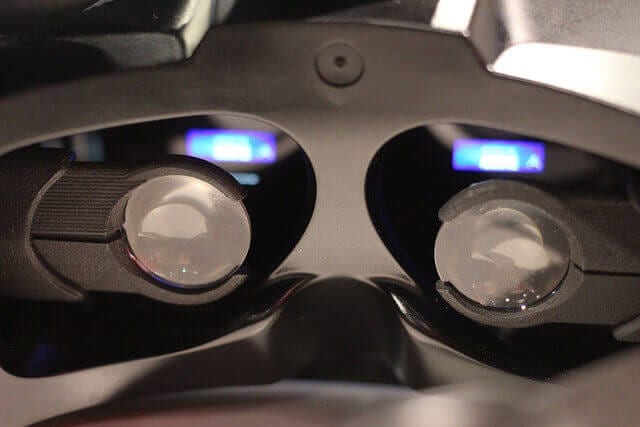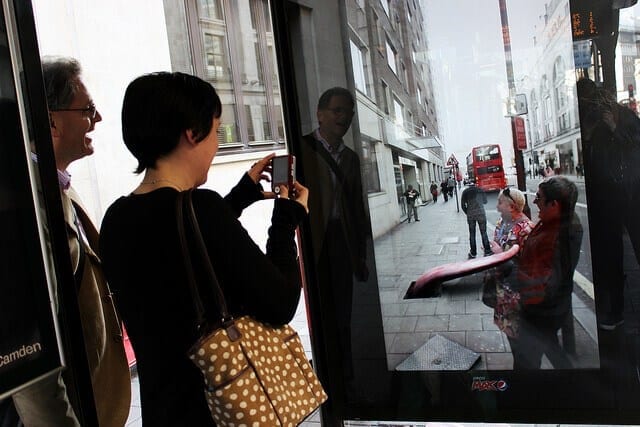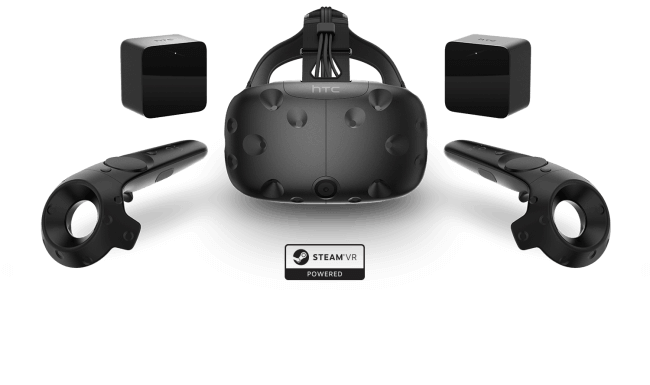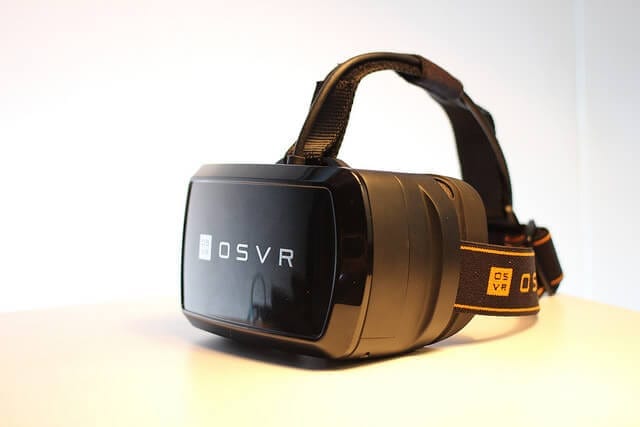Two years have passed since we first wrote the blog post ‘From VR Marketing to vCommerce: What Can Virtual Reality Do For Your Business?’ In our 2018 update, we explore the future of VR and the various uses, opportunities and applications in businesses. We thought it would be good to take a look at the original post and add to it and comment on whether or not businesses have adopted VR in the ways we had expected.
Editor’s Note: This post was originally published in June 2016 as part of our “Virtual Reality for Business series” reviewing the technology, applications and predictions at the time. Technology moves fast and things have changed a lot in the two years since 2016, so we have decided to update the original post to identify what has changed and how businesses are actually using VR (if at all) in 2018.
What has changed in the last two years?
- 1 What has changed in the last two years?
- 2 VR hardware improvements
- 3 VR’s Bright future in vCommerce and unique visual experiences
- 4 An updated interview with Adam and Rob
- 5 — 2016 article ‘From VR Marketing to vCommerce: What Can Virtual Reality Do For Your Business?’ —
- 6 A bit of background…
- 7 If you don’t feel like reading, explore our infographic…
- 8 So, what is virtual reality (VR)?
- 9 Virtual reality for marketers and business owners
- 10 Virtual reality vs. augmented reality
- 11 Can open-source and virtual reality Combine?
- 12 Website design using virtual reality
- 13 So what can virtual reality do for your business?
Since 2016, we have seen many businesses make the switch to VR when it came to marketing and customer experiences. That’s not to say that more ‘traditional’ forms of customer experiences and marketing are going anywhere anytime soon. VR is just another tool in the markers toolbelt when it comes to bringing a product or service right to the customer with relatively minimal effort for maximum effect.
VR uses and applications in business?
Over the last year we have seen businesses such as Ikea offer an ‘in store’ experience without the customer having to be in store. By utilising VR, Ikea have managed to create a virtual store where the user can navigate around the store, read digital versions of their catalogue and even walk up to products and add them to your cart.

A Customer VR experience at IKEA
VR has made these types of ‘virtual stores’ possible but users that haven’t got VR headsets just yet can still gain a benefit from these new technologies. Many of the websites made for VR will work on mobile devices as well as traditional PCs resulting in a super realistic albeit less immersive experience. You typically can touch areas of the screen and pinch to zoom in giving you a much more interactive way to view the products you are interested in even without a Virtual Reality headset.
VR offers practical solutions to physically disabled customers
One way that businesses can utilise VR is to help with granting store access to disabled customers where the business’ physical location may not be ideal to attend physically due to factors such as no ramp access for example. Being able to offer these experiences in VR isn’t just a gimmick as some might see it – it offers a real practical solution to certain user groups and allows people to experience the thrill of retail from the comfort of their homes.
In addition, Virtual Reality will prove to a be a practical way to assist children with learning difficulties by allowing them to learn in an improved visual way which wouldn’t be possible without the use of VR.
VR has also become an essential tool to specialists that are looking to learn and train to become a professional in their field. In addition to this, we are now able to remove some of the risk associated with certain delicate medical procedures. For example, American doctors are utilising VR to solve complex problems that would be very difficult to otherwise tackle and prepare for.
The benefits of VR are far reaching and we are only at the tip of the iceberg of what these new technologies will be able to offer multiple industries over time and iterations of headsets with added improvements.
VR now offers objectively superior customer experiences compared to traditional ‘on location’ experiences
The conversation around VR typically revolves around whether or not the virtual experience lives up to that of the physical one but today, some VR experiences surpass it and are more practical. Audi have been working on a VR experience that allows customers to view any combination of potential configurations of vehicles for sale – something which would be impossible to do at a physical showroom.
Virtual Reality has removed the physical bottleneck in terms of the logistics of customer experiences and marketing. As time goes on it becomes more and more clear that in 2018 and beyond, we are only limited by our imagination when it comes to creating experiences for clients and customers whether its showrooms, retail stores or proof-of-concept presentations that wouldn’t be possible with the more traditional 2D diagrams and illustrations.
VR doesn’t just offer the ability to build upon an already existing marketing philosophy to generate completely new customer experiences – it can enhance more traditional already existing customer experiences, so marketers can truly have the best of both worlds when it comes to implementing VR into their strategy.
VR hardware improvements
Since posting the original edit of the blog, hardware specifications on VR headsets have improved greatly. Screen resolutions have improved allowing users to see detailed images closer in the distance, and being able to take in more information opening up more possibilities to retailers that were holding off due to not being able to see the smaller details on the products.
Another issue that stopped some organisations from utilising VR was the price point. VR headsets, like any new technology, were initially very expensive and classed as enthusiast tier products just for those techies that want to be at the bleeding edge of technology and new experiences. However, this has changed recently with a price reduction of the post popular headsets opening the experience up to new user bases and as a result making it more viable to businesses on the fence about adding a VR experience to their marketing strategy.
Arguably, the biggest leap in terms of hardware improvements are the wireless connectivity on VR headsets. Currently, companies are starting to release wireless adapters to transform their VR experience to the next level by removing the wiring that can get in the way and ruin the immersion for users. This tech is still in its early days but the fact that wireless technology is being utilised via adapters and built in wireless rumoured for upcoming headsets, it’s a huge step in the right direction for Virtual Reality.
VR’s Bright future in vCommerce and unique visual experiences
“Any sufficiently advanced technology is indistinguishable from magic.” – Arthur C. Clarke
It is still an exciting time for VR – Facebook owned Oculus are currently working on a variety of headsets to follow on from the Rift to appeal to wider demographics with multiple usage scenarios. Some will function as more standalone units that are wireless whereas the most anticipated will be a direct follow up to the original Oculus Rift primarily used for entertainment and gaming.
Valve and HTC are also working on a follow up to their Vive headset which is the Rift’s main competition which should make use of improvements in screen technology and potentially wireless connectivity.
We’re quite a way off the ideal version of VR and are right at the start of the Virtual Reality timeline. In the future it isn’t hard to imagine being able to have a tiny contact lens type device that is able to augment reality in addition to being able to create a VR experience, but the form factor will continue to become smaller making it more ergonomic and generally convenient for the user wear and use. I think most of us will look back at this current stage of VR with the same type of view we have looking back at early TVs, VHS tapes or any technology that’s was once in its infancy.
For those that still haven’t tried VR, I would encourage you to do so by trying many of the free demos available on the headsets software stores. Before trying VR I thought it would just be comparable to having a screen right in front of your face that reacts to your movement but I couldn’t have been more wrong. The sense of scale and depth is shocking, you feel as if you really are in these virtual words and its easy to see the endless possibilities and usage scenarios that I’m sure we’ll see more of in the future once more of an audience has adopted the new technology.
Currently, many businesses are sceptical about VR and its use in their marketing and business in general. Hopefully now we are starting to see professionals utilise the technology, it will become a more viable platform for investment in terms of their time and money.
An updated interview with Adam and Rob
To follow on, myself and Robert Bryan discuss VR and the points mentioned in this blog in a brief conversation we thought it’d be useful to share below
Editor’s Note: This post was originally published in June 2016 as part of our “Virtual Reality for Business series” when VR was very new technology and business utilisation was mainly in the ideas phase. Things have changed a lot in the two years since 2016, so we have decided to update the original post to reflect changes that have taken place in those years.
— 2016 article ‘From VR Marketing to vCommerce: What Can Virtual Reality Do For Your Business?’ —
A bit of background…
As many of our readers may know, we’ve been following the rise of virtual reality here at Opace for some time now. Our chief technical guru Rob was one of the early adopters of ‘recent VR’ technologies and first blogged about his experiences with the Oculus Rift back in 2014 with the article Social media in a virtual reality world: Last month Facebook acquired Oculus Rift, so what next? It’s been a bit of a hobby of Rob’s and for anybody interested you can see some of this VR simulations and technology reviews here.
In fact we’re all a bit obsessed with VR at the moment and have been exploring ideas around how VR might transform the business world and have decided to interview our experts.

Rob and Adam on VR
For the full interview with Rob and Adam, you can read The Lowdown from Our VR Gurus, Rob and Adam but we’ve decided to take this one step further and produce a series of articles and infographic, hopefully to drum up some discussion and debate around where this interesting and game-changing technology is heading:
- The History, Rise & Fall of Virtual Reality
- Has Oculus Lost the First Generation of Virtual Reality to HTC
- How Marketers Can Use Virtual Reality
- Virtual Reality vs. Augmented Reality & the Applications for Business
- Open Source Virtual Reality and What This Means for Business
- Virtual Reality Web Design; Why Every Business Will Need to Factor VR into Their Digital Marketing
- Virtual Reality eCommerce & the Future of Online Shopping (vCommerce)
- The Lowdown from Our VR Gurus, Rob and Adam
If you don’t feel like reading, explore our infographic…
[gdlr_frame type=”solid” align=”left” caption=”Virtual Reality (VR) for Business Infographic by Opace” background_color=”#99d15e”] [gdlr_image_link type=”image” image_url=”https://www.opace.co.uk/wp-content/uploads/2016/06/Virtual-Reality-VR-for-Business-Infographic-v4.jpg” alt=”Virtual Reality (VR) for Business Infographx” alt=”Virtual Reality (VR) for Business Infographic” width=”650″ height=”385″ class=”fancy wp-image-4557 size-post-slider-bottom” alt=”Virtual Reality (VR) for Business Infographic” link_url=”https://www.opace.co.uk/wp-content/uploads/2016/06/Virtual-Reality-VR-for-Business-Infographic-v4.jpg” alt=”Virtual Reality (VR) for Business Infographic” width=”650″ height=”385″ class=”wp-image-4557 size-post-slider-bottom” width=”800px”][/gdlr_frame]
So, what is virtual reality (VR)?
Virtual reality is not a new phenomenon and. In fact, it dates back as a concept to the 1950s. Since then it has seen a rise, when a group of visionaries saw the possibility for virtual reality on screens, and then a fall when this vision couldn’t be realised. The technology wasn’t good enough, the visuals weren’t up to scratch and the concept, rather than becoming reality itself, remained a fantasy.
By the 1990s, virtual reality had all but died as an idea worth pursuing and instead, was reserved as a theme to be used in cinema films such as The Lawnmower Man, Virtuosity and The Matrix. However, since virtual reality’s rise and fall, it is witnessing a dramatic re-rising and is now one of the hottest buzzwords in not only the tech and gaming worlds but also the world of business and social media.

A virtual reality headset – Credit: Maurizio Pesce
After Sony’s release of the PS3, which was the first gaming console to include Blu-ray, people were asking, “what’s next?” It became clear that the next big thing was going to be virtual reality after Facebook acquired Oculus Rift in 2014. At the time, Oculus were the only real serious contenders for the prize of virtual reality kings, and people weren’t seriously thinking about the uses for virtual reality for business.
Since then we’ve seen a wave of big name brands get behind the concept of virtual reality, including the HTC Vive, Samsung Gear VR,PlayStation VR and the Google Cardboard. Having now explored and tested each of these technologies, we’ve come to the conclusion at Opace that the HTC Vive is now winning the race, with Rob commenting that “the HTC Vive has completely blown all other competition out of the water.”

The HTC Vive VR pack
Regardless of who is currently in first place, there is no denying that the virtual reality industry is going to be huge, with a projected revenue of $5.1 billion for the gaming industry alone in 2016. It looks as though the HTC Vive may be winning this race, but each headset offers something a little different, whether this is in the product itself, the price or the scope of the headset.
For further details on the race for VR, read on here.
But it’s not just a change in the attitude of companies that we’ve seen towards virtual reality. There’s also been a dramatic change in the way virtual reality itself is viewed. It’s no longer just ‘the next big thing for gaming’. It’s now a revolutionary concept in itself with uses for all walks of life. Whether this is for people viewing a house they may want to buy, customers getting a feel for a new store before it’s even been built or for marketers to find new ways to demo their products, virtual reality is now a serious piece of technology that has the ability to transform the way in which companies do business.
Virtual reality for marketers and business owners
So just what can virtual reality do for business? We know that its scope within the gaming industry will be huge, giving players the chance to fully immerse themselves in the worlds that they have been playing in for so many years. With this, virtual reality is going to take gaming to the next level. But will it be able to take businesses to a new immersive level as well?
Marketing
On a marketing level, the business possibilities with virtual reality are huge. For a start, businesses can now demo and promote their product in an entirely new way to consumers. When the internet and online shopping became mainstream, the way that we shopped was revolutionised forever. Customers no longer needed to make a trip to the nearest shopping centre for their goods; they could browse, purchase and receive these products directly to their door. So that’s the end of that, right?
eCommerce
Surprisingly, despite this ability to be able to order a whole new wardrobe from the comfort of their sofas, consumers are still uneasy about shopping online. In fact, a survey from TimeTrade found that 85% of consumers still prefer to shop in physical stores, and even 71% of consumers would prefer to shop at an Amazon store over Amazon.com.
This is down to varying reasons, but the chief reason among consumers is that they want to touch and feel a product before they purchase it, with 85% agreeing on this. This is where virtual reality comes in. It’ll bridge the gap between the eCommerce site and the physical store, allowing consumers to view the products as though it were real. They may not be able to hold the physical product, but viewing it in virtual reality is a world away from scrolling through 2D pictures online.
Marketers need not stop here either; they can also adopt virtual reality into an effective social media strategy. This one might not seem so obvious at first, but let’s not forget that Facebook, the largest social media platform on the planet with a user base of 1.51 billion, are perfectly placed to bridge the gap between virtual reality and social media with their Oculus Rift.
In fact, Facebook only just recently announced a dedicated social virtual reality team. We first saw the appearance of 360-degree videos on Facebook’s News Feed, so it’s not surprising that they want to try and put this service out on a more global scale. Marketers can adopt these 360-degree videos as a way of better connecting with customers through Facebook, and really show them a product or service to a much higher level than before.
Communications
Alongside this, virtual reality has the chance to strengthen the connections that businesses and marketers have with consumers. We are more connected than ever, and yet somehow these connections have become fractured and much less personal. Despite the recent announcement that it is shutting down, apps like Convrge were great in getting people to interact in a new way using virtual reality.
Supposedly 93% of communication is non-verbal, and while some disagree with that statistic, there can be no denying that body language plays a huge part in the way in which we communicate with others, and ultimately the way in which we buy and sell to others. Virtual reality for social media will allow marketers and businesses to use an entirely new set of online selling tactics to their customers.
A survey from Gallup found that 94% of consumers use social media primarily to connect with family and friends, and 62% said that social media had no influence whatsoever in their purchasing trends, especially as people don’t want to know that they’re being sold to most of the time. Virtual reality will allow businesses to sell to consumers without really having to ‘sell’ to them at all.
For further detail on the business and marketing applications of VR, read on here.
Virtual reality vs. augmented reality
Another buzzword that is appearing a lot more frequently now is ‘augmented reality’. Virtual reality, as we know, is about the creation of a virtual world in which the users can experience something completely different from what they are used to. Augmented reality, on the other hand, is more of a blend of virtual reality with the real world. As Mashable describe it, it “is a live, direct or indirect, view of a physical, real-world environment whose elements are augmented by computer-generated sensory input such as sound, video, graphics or GPS data.”
For example, Pepsi Max created an augmented reality bus shelter in which viewers believed they were viewing the street through glass when in fact it was a screen that Pepsi had various things added in to. It’s not quite real, but it’s not quite fully virtual either. So how does augmented reality compare to virtual reality when it comes to business?

Pepsi’s Augmented Reality – credit: JCDecaux Creative Solutions
Virtual reality is the only medium that will guarantee a user’s undivided attention in the virtual world before them. It is the only way to get a customer truly immersed in the story that you are trying to tell, and it is the most lifelike experience possible. Some, however, argue that this is virtual reality’s biggest downfall. This complete immersion in another world means that the user is taken out of the moment and placed into another one. They can’t see what is happening around them or interact with those in the immediate vicinity. Because of this, it will never become part of our daily lives. We may use it daily, but we have to take a break from what we are doing to use it.
Augmented reality, on the other hand, simply adds another layer of information to our real world experiences. As TechCrunch write, “both VR and AR tinker with our reality – but AR enhances it, while VR diverts us from it.” With this in mind, some of the uses that augmented reality could have for business, as ZDNet highlight, are:
- Remote Guidance – workers who are out remotely in the field could use some form of augmented reality, such as Google Glass, to have information fed to them on how to solve the problem they’re currently facing.
- Better Training – training could be much more elaborate than it is currently, and the worker could experience a particular scenario time and time again.
- Visualising Objects – virtual objects can be placed in the real world, which could allow designers a new way of interacting with a virtual 3D model.
- Customer Service – customers can view products in a new way while remaining in the real world. For example, Lowe’s Holoroom allows customers the chance to explore a virtual 3D environment by walking around the room around them. Adopted correctly, this could be great for a business’ marketing strategy.
- New Ways of Working – augmented reality could capture information that is in front of it and feed this back to the worker. For example, it could examine the damage done to a car and feed back exactly how much it would cost to fix it.
Ultimately, both virtual reality and augmented reality offer new ways for businesses to interact with their customers. It’s easy to compare them, but as they both offer something different to the other, it’s important for businesses to consider adopting both into their marketing strategies.
For instance, the earlier example that we saw from Pepsi was done expertly, and wouldn’t have worked if the people waiting at the bus stop had been asked to put on a virtual reality headset. But equally, other examples, such as the Marriott’s Teleporter which transported honeymoon hopefuls to a beach on Hawaii, wouldn’t have been as effective with augmented reality. In the same way that Pepsi picked the correct medium, Marriott needed to immerse the users as much as possible, and this couldn’t have been achieved using augmented reality.
It’s true that virtual reality is more for content and augmented reality is more for the real world, but just as digital marketing strategies now involve more than channel to deliver content, so too should a business’ strategy when it comes to adopting different realities.

Augmented Reality – image credit: Flickr
For further detail on the differences between VR and AR, read on here.
Can open-source and virtual reality Combine?
If you know us here at Opace, then you know that we love all things open source. That’s why we love the idea of combining open source technology with virtual reality. There is one dedicated virtual reality company that is aiming to do this; the aptly named Open-Source Virtual Reality (OSVR).

OSVR – Open-Source Virtual Reality for Gaming
The software and hardware designs with OSVR are completely open for anyone and everyone to develop with. OSVR, as it stands, is to be a dedicated gaming headset, although the company has admitted that their technology can be used for almost anything.
Furthermore, OSVR is designed to run on Linux, Android, and Windows and has been designed to run alongside all head-mounted displays (HMD) such as Oculus, rather than acting as a competitor against them. Why have OSVR taken this large, open-source approach to virtual reality? They believe that virtual reality is still some way off being a proper consumer product, and so they hope that their open source platform will help speed up the process.
While it’s clear that OSVR will be a serious contender in the gaming market, what could open source and virtual reality do for business? As previously mentioned, having a whole community of virtual reality loving tech heads will accelerate development tenfold. There is nothing wrong with an approach like this and even big companies like Facebook have a ‘Bug Bounty’ as they know two heads are better than one, especially if it involves bringing in outside knowledge.
In their product launch video, OSVR admit themselves that the virtual reality industry still has a lot to do, and an open-source platform could go a long way in bridging the gap between making virtual reality a fantasy and reality. With the creation of more technologies, more software and more apps, an open source virtual reality platform could have an endless list of possibilities for not just gamers, but businesses too.
We’ve seen this previous open source platforms, such as our much loved WordPress which started out as nothing more than simple blogging technology and now powers some of the world’s biggest websites including TechCrunch as well as many others. It will be interesting to see just how the community can help take virtual reality to the next level for businesses as well as gamers.
For further information on open source VR, read on here.
Website design using virtual reality
Obviously website design is a big part of what we do here, so it goes without saying that we’re excited at the thought of being able to combine virtual reality and website design together. While some are debating whether a truly virtual world wide web is possible, whereby users can click through on a Wikipedia link that takes you not to a page about history, but instead into actual historical landscapes themselves, we think it’s important to look at the immediate first step to that.
We’ve already talked about how businesses could showcase their products, services or stores in virtual reality, so why should this feature not simply be pre-built into their existing website design? While it may seem like a crazy idea now, it wasn’t that long ago that people dismissed Steve Jobs’ announcement of the iPhone in 2007 as nothing more than a crazy dream. Bloomberg wrote that “the iPhone’s impact will be minimal.”, PC Magazine wrongly predicted “Apple will sell lots at first and then sales will plummet” and MarketWatch said “the “one phone fits all” concept is ridiculous.” Then in 2015 Google overhauled their famously secretive algorithm to reward those websites that were mobile responsive, as smartphones have now risen beyond anyone’s wildest dreams.
Why could the same thing not happen with virtual reality? Well we expect it will, especially given the data. With 84% of consumers still prefering to visit a physical store than an eCommerce site, virtual reality could do wonders to curb this number down. If virtual reality can allow people visit websites over a physical store, then there is no reason why brands shouldn’t be forced to adopt virtual reality into their website design.
Perhaps not all sections of the website need to be in virtual reality, but a product page that allows the viewers to see the products as they are in real life would go a long way in increasing revenue through the eCommerce site. Of course, this could be done to varying degrees, but businesses that have real vision for their online store could make their eCommerce site look exactly like a physical store, with different products in different isles; giving shoppers a real-life shopping experience from the comfort of their homes.
One Google employee, Boris Smus, goes one step further in saying that developers could build the VR experiences that they want in HTML and then run them from a browser. This idea, known as WebVR, is supported by many big name brands including Mozilla Firefox, who launched their own MozVR website for virtual reality experiences that are web-based. Google then responded by launching VR Chrome Experiments.
As it stands, no big name brands are really making use of this technology. The JavaScript standard for virtual websites does exist, titled WebVR, but isn’t currently very good, as admitted by its creator Casey Yee, so any sites that are using it aren’t fully established yet. They aren’t fully woven into the world wide web and act more as standalone websites for a WebVR experience. However, there is great potential there to have an internet full of virtual reality websites all interconnected with each other.
Rob and Adam at Opace are particularly excited about the future of virtual reality web design but have said that unfortunately at this stage the platform simply isn’t out there to support this, and have said that “it won’t be long before your room can be transformed into an eCommerce store, but currently there is no platform for giving a customer a virtual reality experience. Until that happens it’s difficult to offer solutions.” It will be interesting to see how businesses adopt virtual reality when it becomes more mainstream, and the team here at Opace are certainly getting ready to incorporate this into our web design strategy.
For further information on VR web design, read on here.
So what can virtual reality do for your business?
While it’s clear that virtual reality is the next big thing, it still has a way to go. However, when it comes to virtual reality, the possibilities are endless and businesses that make use of this adaptable, scalable and immersive technology early on will find themselves getting ahead of their competitors.
With everything from virtual reality web design to virtual reality product testing, this technology truly offers a new way for businesses to connect with customers and it’s not often that we see a new piece of software or hardware that allows for this. Virtual reality offers the chance for businesses to take their marketing strategy to a new level in much the same way as social media did a few years ago. It will be interesting to see how businesses adopt this as the virtual reality technology progresses but in the meantime it would be great to get your ideas, feedback and thoughts. Please don’t hesitate to drop us a comment below (no spam please) and we’ll get back to you.

![Seo content creation guide for good content - why good content matters: seo content creation guidelines [updated] Seo content creation guidelines for good content](https://www.opace.co.uk/wp-content/uploads/2024/03/SEO-content-creation-guide-for-good-content-150x150.jpeg)




0 Comments